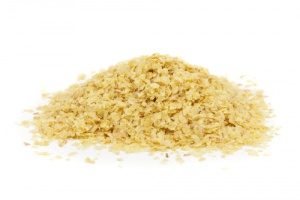Wheat Germ
| See Also | Food Supplements |
|---|
Wheat germ is the embryo of the wheat grain located at the lower end. It is removed along with the bran during processing of wheat grain into refined white flour. It contains many nutrients such as calcium, copper, magnesium, manganese, thiamin, riboflavin, folic acid and most other B vitamins, phosphorus, vitamin E, protein, and phytosterols. When supplemented, it is an excellent source of these nutrients.
Food Sources
The following foods have the highest concentration of wheat germ:
- whole grain cereals, breads, and other products
- it can also be purchased separate from the whole grain and added to baking and cooking
Wheat germ goes rancid quickly. Store in a cool dry place but do not freeze.
The nutritional values of wheat germ include:
- Serving Size: 1 oz, toasted
- Calories: 108
- Fat: 3 g
- Saturated Fat: 1 g
- Cholesterol: 0 mg
- Carbohydrate: 14 g
- Protein: 8 g
- Dietary Fiber: 4 g
- Sodium: 1 mg
- Folic Acid: 100 mcg
- Pantothenic Acid: <1 mg Riboflavin: <1 mg
- Thiamin: 1 mg
- Vitamin B6: <1 mg
- Vitamin E: 4 mg
- Calcium: 13 mg
- Copper: <1 mg
- Iron: 3 mg
- Magnesium: 91 mg
- Manganese: 6 mg
- Phosphorus: 325 mg
- Potassium: 269 mg
- Zinc: 5
Uses
- Wheat germ containing its original phytosterol content has important effects on reducing cholesterol absorption in the body. In fact, there was a 42.8% reduction in cholesterol absorption. It is suggested that phytosterols in wheat germ are at least as effective as those found in supplements. The mechanism by which wheat germ is able to lower cholesterol absorption is complex, however, and is likely also due to its fiber content as well as other components.[1].
- Giarida lamblia is a parasite which is a major cause of waterbourne intestinal disease worldwide. Wheat germ in conjunction with conventional treatment with metronidazole may provide better results in terms of reduced cyst passage in asymptomatic individuals compared to conventional treatment alone. In symptomatic individuals, symptoms appeared to resolve faster than in those not receiving wheat germ.[2]
Prescribing Considerations
The recommended dosages have not yet been established. To determine what your specific requirements are talk to your naturopathic doctor or other trained medical professional.
- Wheat germ can be added to breads, pancakes, cookies, cereals, and milk shakes. It's a lower-fat alternative to granola that can be added to yogurt and cereals. When adding wheat germ to baked goods or quick breads, you can replace one half to one cup of the flour with it. Because wheat germ tends to absorb moisture, you may want to add one to two tablespoons of water for every one-quarter cup of wheat germ you add to a recipe.
Safety
Wheat germ is generally considered safe.
- Children: Wheat germ is not recommended in children.
- Pregnancy and Breastfeeding
- Safety of supplementation when pregnant or breast-feeding has not been determined.
References
- ↑ Ostlund RE Jr, Racette SB, Stenson WF (Jun 2003)Inhibition of cholesterol absorption by phytosterol-replete wheat germ compared with phytosterol-depleted wheat germ. Am J Clin Nutr;77(6):1385-9.
- ↑ Grant J, Mahanty S, Khadir A, MacLean JD, Kokoskin E, Yeager B, Joseph L, Diaz J, Gotuzzo E, Mainville N, Ward BJ (Dec 2001) Wheat germ supplement reduces cyst and trophozoite passage in people with giardiasis. Am J Trop Med Hyg;65(6):705-10.
